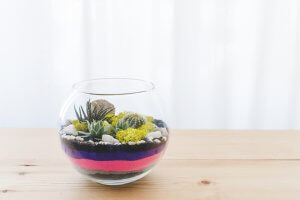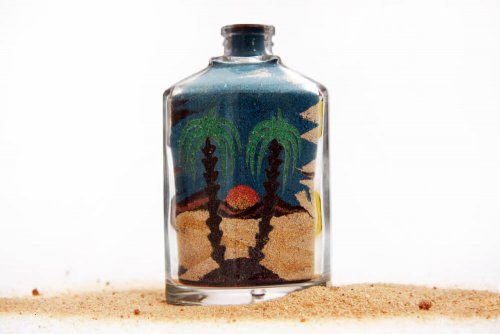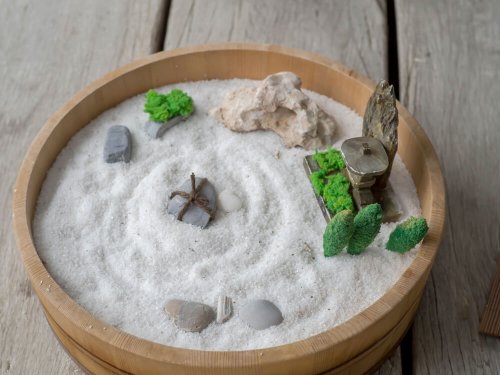Colored Sand - Tips for Adding It to Your Decor

Colored sand isn’t only for children. In fact, it can look highly sophisticated if you use it in the right places around your home. It’ll add a certain je ne sais quoi to your environment.
You might think that colored sand is just for children but you’re wrong. Just as with everything in this life, the look you achieve will depend on your artistic sensitivity.
Don’t say you haven’t any because everyone does. In fact, creativity is about confidently manipulating a technique or a material. Don’t be afraid to fail as this is the way you’ll learn.
For example, you could add natural stones, a plant, and some colored sand to a glass container. Experiment with the blends of colors and be as little or as extravagant as you want to be. Keep in mind that the most beautiful things are simple and natural. Look around and get inspired by nature’s palettes. Have you ever looked at the wonderful colors of that spider you have in one of the corners of your house?
Keep in mind that, sand is not only a good way to add color but also texture to your decor. Even when it’s not the main element or obviously displayed in a glass jar. So, we’d like to give you a few ideas on how to use colored sand to decorate your home.
What makes sand colorful?

The color of the sand is not what determines its use in one way or another, but the characteristics of its original material. We know that:
- Red sand is used in xerophilous gardens because it helps retain moisture for a longer period of time.
- Compacted soap sand is used for trails and roads. This is because it doesn’t turn into mud when it’s wet.
- Likewise, limestone is often used for covering surfaces because it doesn’t turn into mud when wet either.
- Silica sand has coarse particles and functions as the filtering material in pools and purification plants, as well as in construction projects. People also use it in their Zen gardens, centerpieces, vases, and fish tanks.
- Then there’s black sand. Given that it’s made up of a set of grains from broken particles of rock, it’s highly resistant and therefore rather useful in the construction and decoration of exteriors.
- When the sand is dyed then it goes by the name of decorative sand. Also, in some cases, it might include essential oils or perfumes. The most common compositions made with colored sand are superimposed layers to create asymmetric shapes.
Ideas to decorate with colored sand

Here are some ideas for decorating with colored sand:
- Fill a light blue glass bottle with white, blue and gold sand to obtain a nautical look. Add some faux pearls instead of the typical shells for a more “delicate” result.
- You can also fill the bottom of a glass jar with colored sand and then plan succulents above it. It won’t just serve as a layer for proper drainage but it will also add vitality and joy to the container.
- If you have a multisection tray or box you can fill them with colored sand. They’ll make great table accessories. You can take it a step further and add other elements to give them a Zen garden look.
- In addition, you can fill the bottom of a see-through glass container with colored sand and then just add a neutral-colored candle.
Recommendations

If you have an abstract decorative accessory, such as a lamp or a poster, you can use the same color palette to fill one or more glass jars with colored sand. The colors and textures will tie it all together and your eye will wander around the room.
Be subtle with your choices of color, unless your goal is to make a rainbow. Integrate the colors so that they have contrast and balance. For example, you can match deep tones with pastels in the same color, if you like monotone palettes. You could also mix neutral colors with higher intensity ones. Again, nature is inspiring when it comes to color combinations. Look around you.
Thanks for reading.
Colored sand isn’t only for children. In fact, it can look highly sophisticated if you use it in the right places around your home. It’ll add a certain je ne sais quoi to your environment.
You might think that colored sand is just for children but you’re wrong. Just as with everything in this life, the look you achieve will depend on your artistic sensitivity.
Don’t say you haven’t any because everyone does. In fact, creativity is about confidently manipulating a technique or a material. Don’t be afraid to fail as this is the way you’ll learn.
For example, you could add natural stones, a plant, and some colored sand to a glass container. Experiment with the blends of colors and be as little or as extravagant as you want to be. Keep in mind that the most beautiful things are simple and natural. Look around and get inspired by nature’s palettes. Have you ever looked at the wonderful colors of that spider you have in one of the corners of your house?
Keep in mind that, sand is not only a good way to add color but also texture to your decor. Even when it’s not the main element or obviously displayed in a glass jar. So, we’d like to give you a few ideas on how to use colored sand to decorate your home.
What makes sand colorful?

The color of the sand is not what determines its use in one way or another, but the characteristics of its original material. We know that:
- Red sand is used in xerophilous gardens because it helps retain moisture for a longer period of time.
- Compacted soap sand is used for trails and roads. This is because it doesn’t turn into mud when it’s wet.
- Likewise, limestone is often used for covering surfaces because it doesn’t turn into mud when wet either.
- Silica sand has coarse particles and functions as the filtering material in pools and purification plants, as well as in construction projects. People also use it in their Zen gardens, centerpieces, vases, and fish tanks.
- Then there’s black sand. Given that it’s made up of a set of grains from broken particles of rock, it’s highly resistant and therefore rather useful in the construction and decoration of exteriors.
- When the sand is dyed then it goes by the name of decorative sand. Also, in some cases, it might include essential oils or perfumes. The most common compositions made with colored sand are superimposed layers to create asymmetric shapes.
Ideas to decorate with colored sand

Here are some ideas for decorating with colored sand:
- Fill a light blue glass bottle with white, blue and gold sand to obtain a nautical look. Add some faux pearls instead of the typical shells for a more “delicate” result.
- You can also fill the bottom of a glass jar with colored sand and then plan succulents above it. It won’t just serve as a layer for proper drainage but it will also add vitality and joy to the container.
- If you have a multisection tray or box you can fill them with colored sand. They’ll make great table accessories. You can take it a step further and add other elements to give them a Zen garden look.
- In addition, you can fill the bottom of a see-through glass container with colored sand and then just add a neutral-colored candle.
Recommendations

If you have an abstract decorative accessory, such as a lamp or a poster, you can use the same color palette to fill one or more glass jars with colored sand. The colors and textures will tie it all together and your eye will wander around the room.
Be subtle with your choices of color, unless your goal is to make a rainbow. Integrate the colors so that they have contrast and balance. For example, you can match deep tones with pastels in the same color, if you like monotone palettes. You could also mix neutral colors with higher intensity ones. Again, nature is inspiring when it comes to color combinations. Look around you.
Thanks for reading.







